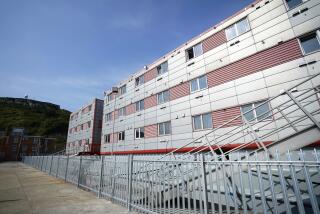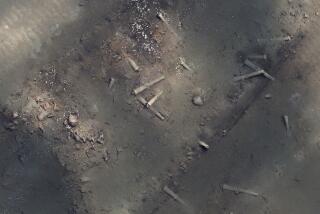Relatives Recoil at Swedish Plan for Sunken Ferry
- Share via
BORLANGE, Sweden — When Lennart and Birgitta Berglund imagine those horrible last moments in the raging Baltic Sea, they like to think Birgitta’s parents met death’s cold advance in the warmth of each other’s arms.
Maybe the vacationing couple stayed behind in their cabin as the crippled ferry Estonia flipped on its side and was sucked from the horizon. And maybe they are still there--locked in their final embrace 250 feet beneath the sea.
“But we are realistic,” Lennart Berglund said. “This was a catastrophe, and they probably got separated. We can accept that if it is true. But we need to clear this up once and for all.”
The Berglunds are among the hundreds of families from 24 countries who lost loved ones aboard the Estonia, an ocean-liner-sized passenger and car ferry that sailed the popular nine-hour party run between Estonia and Sweden. The ship sank off the coast of Finland in September 1994 after heavy seas ripped off the car deck’s outer bow door, killing 852 people in Europe’s worst peacetime disaster at sea this century.
The Berglunds are also the leaders of a determined group of relatives, many from this central Swedish steel town that was home to 50 of the dead, who are angered and troubled by an elaborate government effort to forever cut them off from the wreckage. If the government doesn’t back down, the Berglunds say, they have arranged to raid the site and seize Birgitta’s parents.
“It is not the bodies themselves that are so important. It is that you have done what is expected of you as a human being,” Lennart Berglund said. “You are supposed to put a family member to rest, whether it takes one year or 50.”
On the order of Swedish authorities, 25,000 tons of gravel are being deposited around the sunken vessel as the foundation for a gigantic 12-inch-thick concrete sarcophagus. The $45-million project is to encase the ferry--and its hundreds of entombed passengers--in an impenetrable underwater mausoleum by summer’s end.
The Swedish government, bankroller of the effort, says the structure will provide a fitting memorial to the 519 Swedes and 333 others who perished, while also keeping out plunderers and adventurers already drawn by the notoriety of the site and its possible great riches.
A salvage effort, officials say, has been ruled out as too perilous and too gruesome, although government investigators have examined the wreckage closely enough to report that about 300 of an estimated 700 to 800 trapped bodies are within reach. The ferry, nearly upside down, is lodged on a sloping seabed about 60 miles off southwest Finland.
“There is a maritime tradition when it comes to people lost at sea,” said Anders Iacobaeus, head of legal affairs for the Swedish Ministry of Transport and Communications, which has responsibility for the Estonia. “The sea is a burial ground. You don’t go down and disturb bodies.”
But in a race against the clock, desperate relatives are pressing the government to halt construction of the massive sarcophagus, while rushing to hire ships for a possible last-ditch effort to recover corpses themselves.
In Sweden, Finland and nearby Estonia, such free-lance expeditions have been made punishable by two years in jail, but defiant family members are looking to ships from neighboring countries to skirt the national prohibitions.
“Wanting to get back a lost relative is a natural thing,” said Lennart Lindgren of the Borlange Metalworkers Union, which lost 38 members and spouses aboard the ship. “Certainly no one can support burying them in concrete.”
Emotions are running so high that some family members have threatened to lay mines near the wreckage to prevent continued work, while others have waged street demonstrations, most recently in Tallinn, the Estonian capital.
The Finnish coast guard is monitoring the wreckage with radar, and ships patrol the area to dissuade anyone from approaching.
A Swedish accident investigator said that patrols cannot block people from outside Sweden, Finland and Estonia from exploring the site but that they can make such visits as unpleasant as possible.
“You send out ships that make waves while at the same time you put diplomatic pressure on the countries where the divers come from,” said Olof Forssberg, director general of the Swedish Board of Accident Investigation. “I think everything would be done to keep people away.”
But Peter Barasinski, a Polish-born Swedish citizen who has already made one unsuccessful effort to retrieve the body of his wife, Carita, said nothing will stop him from trying over and over again.
Barasinski met his wife seven years ago when they worked as crew members on another Baltic ferry. The couple often sailed and went scuba diving together, and though they never talked of dying on a ferry, they did broach the subject of a scuba accident.
“We promised that if one of us were to drown, the other would take the body up to the surface,” said a glassy-eyed Barasinski, his wife peering over his shoulder from an oversize photograph in his Stockholm apartment. “I’ve talked to two survivors who saw her for the last time. I know where she is. After the Vietnam War, families wanted to bring home the bodies of soldiers they could find. It is no different for me.”
Despite growing pressure from families and an expanding corps of international lawyers, Swedish government officials have so far not budged on the issue. Newly appointed Prime Minister Goran Persson hinted last month that the decision was open for discussion, but he later backed off when Transport Minister Ines Uusmann corrected him.
In March, a Swedish court ruled that there were no legal grounds to overrule the government, and officials with Nordic Marine Contractors, the consortium commissioned to cover the Estonia, said they would move forward without delay.
“I understand the desire of people who wanted to recover bodies during the first months after the accident,” said Iacobaeus, a top aide to Uusmann. “But those who want to do it now--I find it, well, sick. You have to let bygones be bygones.”
The decision to allow the Estonia to rest for eternity was made less than two months after the sinking and has been disputed ever since.
Initially, Swedish politicians promised to raise the wreckage and return its doomed passengers and crew to the surface. A deep-sea investigation determined that was technically possible--at about twice the cost of covering the wreckage with concrete--but an ethics panel set up to advise the government recommended against it.
The government followed the advice of the ethics group--which also suggested that the ship be permanently secured--but has waited to cover the vessel until an international accident commission completes its investigation.
The commission of Swedes, Finns and Estonians is not expected to issue its findings before August. But since it has finished combing the wreckage for clues, work on covering the vessel was able to begin last month.
“We have examined the wreck to the extent that we need to,” said Forssberg, who heads the Swedish contingent on the commission. “From our point of view, they can cover it.”
Although preliminary findings point to a construction defect as the cause of the accident, conspiracy theories abound. The Estonia’s loss of life for Sweden, which sat out both world wars, has no parallel in modern times; only the still-unsolved 1986 assassination of Prime Minister Olof Palme has upset national sensibilities more.
Some media reports allege that the Russian mafia, which uses Baltic ferries to smuggle goods to Scandinavia, ordered doors on the car deck opened in order to dump narcotics and illegal metals overboard after Swedish customs officials caught on to the illicit cargo.
Forssberg dismissed the hypothesis, but a separate accident commission set up by the ferry’s German shipbuilders, Meyer Werft, said the claim was serious enough to warrant further investigation.
The German group said covering the ship with concrete is “difficult to understand” since it would “inevitably destroy evidence in a pending proceeding.” A large organization of survivors and relatives, many of whom oppose efforts to retrieve corpses from the wreckage, have raised similar concerns because they have sued the shipbuilder and fear the concrete tomb will become an excuse for the company to escape liability.
In the end, such legal considerations have the best chance of delaying or quashing completion of the concrete sarcophagus. Where appeals of bereaved relatives have not been persuasive, the threat of a legal imbroglio has gotten government officials’ attention: Last week, the transport ministry set up a panel of experts to look into the legal matters.
“This boat will for hundreds of years be followed by myths of different kinds,” said Kent Harstedt, a Swedish Foreign Ministry official who was one of 137 people to survive the disaster. “That is one reason why there should be access to the boat. We really need to get justice, but we also need to get the truth.”
(BEGIN TEXT OF INFOBOX / INFOGRAPHIC)
Burial at Sea
A $45-million project will encase the ferry Estonia and its 852 victims, who drowned when the vessel sank in September 1994. Swedish authorities say the structure will protect the victims from plunderers. Desperate relatives are rushing to hire ships to recover the corpses themselves.
Source: Los Angeles Times
More to Read
Sign up for Essential California
The most important California stories and recommendations in your inbox every morning.
You may occasionally receive promotional content from the Los Angeles Times.













